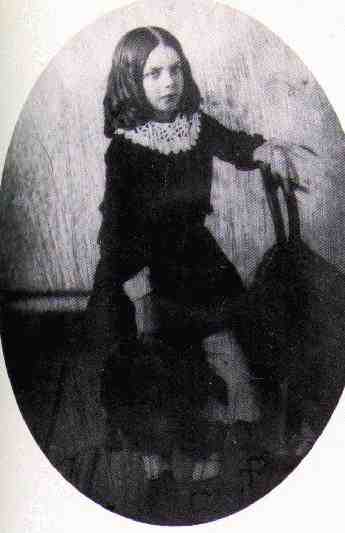
English Boys' Clothes during the 1820s through the 1850s:
The Barretts and Brownings
Elizabeth Barett Browning and Robert Browning are two of England's most noted romantic poets. Elizabeth grew up in a priviliged, wealthy family. Their mother, like many mothers of the era, dressed her sons in the same dresses and pantalettes as her daughters. Elizabeth and
her siblings were schooled at home. She was an accomplished student. She led a closeted life until meeting Robert. The relationship was one of the great love stories of the Victorian era. Elizabeth and Robert had one child, Pen, who Elizabeth schooled at home and dresses with the same flair as her romantic poetry. Pen did not object as a younger boy, enjoying the attention and compliments from his mother's friends. As an older boy he began to object, but with little
success in the face of his strong opinioned mother who had very definite ideas on the subject. Elizabeth is now best known for hautingly beautiful romantic poetry as well as her iterest in women's rights and social justice. A considerable body of literature exists on Elizabeth and Robert. Modern feminist scholars have been particularly interested in Elizabeth. Most
of the literature deals with their relatiinship, petry, and social thinking. A perusal of that literature as well as Elizabeth and Robert's letters yields some interesting information about boys' clothing fashions:
Elizabeth and her 11 brothers and sisters had an idelic childhood. They grewup on a large estate in very comfortable circumstances. Their mother, like many mothers of the era, dressed her sons in the same dresses and pantalettes as her daughters. She apparently
kept the boys in dresses beyond what was common at the time. She insisted that their hair not be cut. Two of Elizabeth's younger brothers had long hair even at 9 and 11 years of age until their father finally ordered that it be cut. Elizabeth and her siblings were schooled at home.
Unfortunately I have very little information on Robert's childhood and what he wore as
a boy. He grew up in a family of fairly modest means. He had no formal schooling beyond the age of 14 years, but was a bright child. He was largely self educated. The mairrage with
Elizabeth was one of the great romance stories of the day. Despite his modest upbrining he rose to become one of England's greatest poets. It is interesting to note that he took a real interest in raising his son Pen with Elizabth. He objected with Elizabeth's permissive approach to child raising. He also disagreed with how Elizabeth dressed Pen, but
did not intervene.
Elizabeth lived a very closeted life until she met Robert and he swept her off her
feet. Her father oposed their mairage. He opposed the mairage of all his children and he had 12! The couple mairred anyway and went off to Italy where they spent several idelic years.

Figure 1.--This photograph of Pen at age 9 in 1858. It is a bit difficult to make out his outfit, but it looks like a dark dress or tunic with an intricate lace collar. The large wide-brimmed hat he is holding, however, obsures the outfit. He appears to be wearing calf-length pantalettes or less likely white petticoats. He also wears very long hair carefully done up in ringlet curls and with a center part.
|
Their son Pen was born in 1849. Pen was the light of Elizabeth's life and both parents
delighted in him. Elizabeth and Robert disagreed on many questiins concerning Pen, including how he was dressed. They discussed intensely every aspect of raising their son. Elizabeth spoiled him outrageously. While pretending to be unconcerned with fashion herself, she actually was quite interested. She was even more interested in expensive, pretty clothes for her son. Pen 'was outfitted in dresses, pantalettes, strap shoes, and tunics. In many
ways similar to how her brothers were dessed. Pen wore long carefully curled hair until his mother's untimely death when he was 11 years old.
Elizabeth is now hearled by modern feminist scholars for her concern over women's
rights and social justice as well as for her beautiful romantic verse. Her belief that men and women were equal was in part reflected by her belief that there should not be such sharp disctinction in masculine and female clothes, especially children's clothes. Her concept about her class and the working class or perhaps beter said, the say she treated working class people it not quite so romantic.
References
Forster, Margaret. Elizabeth Barrett Browning: A Biography (Doubleday: New York, 1989), 400p.
HBC

Navigate the Boys' Historical Clothing Elizabeth Barrett Browning pages:
[Return to the Main Elizabeth Barrett Browning page
[Childhood]
[Poetry and Mairage]
[Son]
[Reflections]
Navigate the Boys' Historical Clothing Web Site:
[Introduction]
[Activities]
[Biographies]
[Chronology]
[Cloth and textiles]
[Clothing styles]
[Countries]
[Topics]
[Bibliographies]
[Contributions]
[FAQs]
[Glossaries]
[Images]
[Satellite sites]
[Tools]
[Boys' Clothing Home]
Created: September 8, 1998
Last updated: 7:51 AM 6/26/2005



